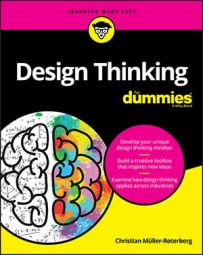The Persona technique can be used to establish distance to yourself while also creating proximity to the customer. In other words, this approach orients you to the customer. Direct your next steps toward this person and, according to this persona, choose the individual needs that you want to focus on. The Persona method also makes it possible to increase awareness of customer needs among employees — in the areas of research, development, and production, for example — without frequent customer contact. Everyone is in the know when it comes to what the persona is supposed to be like, so each and every employee can put themselves in the situation of that individual person. The customer is no longer seen as an anonymous object in an undefined mass, but gets a real character and is thus “brought to life.” Furthermore, you can apply this method inexpensively and combine it with other approaches.
The selected person for the persona represents a fictitious person with individual characteristics that stand for the target users — or at least for some of them.
Rather than configure an average persona, concentrate on coming up with various personas with distinct, unique specifications. The informational yield for an average persona lacks distinctiveness, offering little in the area of fresh ideas for actual innovations.
Represent the different personas carrying out different functions in the buying process. For example, you could include- A persona representing a certain target segment
- A first-time buyer
- Extreme users (ones who use products often or under special conditions)
- Nonbuyers (negative persona)
- Customer and user personae
To get the Persona process started, take a sheet of paper and write up a description of the person in the form of a short profile that makes heavy use of keywords. (Another option is to write short sentences on larger sticky notes and arrange them in an order that works for you. Whatever method you choose, it helps if you assign this persona a specific name.) You shouldn’t reduce the persona to a single characteristic, which is often done in traditional market research, as part of the customer segmentation. You should describe the person holistically in their entire personal environment. A (fictitious) quote or slogan by this persona can start off the description. The figure shows a fully fleshed-out persona.
 Example of the description of a persona.
Example of the description of a persona.The following biographical information can describe this person:
- Gender, age, origin, family status (married or single; children? How many? How old? What parenting style?)
- Profession (job, position), educational background, special knowledge, expert on a specific topic
- Friends and social environment, pets
- Living conditions (own house versus condominium versus rented apartment or shared apartment, as well as type, design, quality, and furnishings of the home)
- Asset status
- Attitudes (values, interests, preferences), frustration tolerance, awareness of health, life goals
- Hobbies and leisure activities (Athletic? Which sport? How often?)
- How much time does the persona have for particular topics or activities?
- Which media and information sources does it use for which topics?
- Attitude toward digital media (User of social networks or more of a loner? Likes to share information with others openly?)
- Consumption habits or factors that influence buying decisions: How fast is the buying decision made? Is this a spontaneous buyer, or is there a tendency to plan? Which information channels does it use? Price-, quality-, or service-oriented? Brand awareness?
- What annoys or frustrates the persona? What problems does it have? What are the persona’s challenges in life? What does the persona consider too expensive, too inconvenient, too time-consuming, too inferior, not user-friendly enough, or too complex? What makes it angry? What risks does it fear? What would the persona be embarrassed about in front of friends? What are its frequent mistakes? What can’t the persona do? What kinds of opposition does it face?
- What are the persona's needs? What does it desire? What does it dream about? What are its goals in life? What are its (buying) motives? What kinds of sale offers does this persona need? What would it expect from such an offer? What would make the persona’s life easier? What would make it happy? What would inspire it? What would make it admired by others?
Bring the persona to life. Give the persona a catchy name that suits the character. Use small drawings to visualize the persona and its environment. Outline what it looks like with its family, when it's indulging in its favorite hobby, or when it performs certain actions and uses particular objects.

